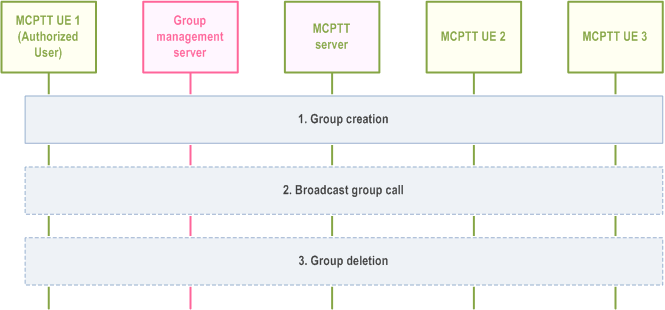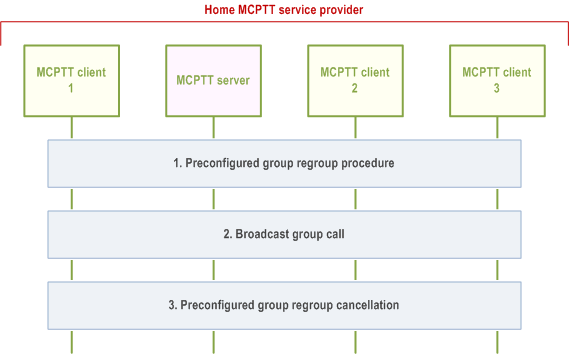Content for TS 23.379 Word version: 19.2.0
1…
7…
7.4…
10…
10.5…
10.6…
10.6.2.2.13…
10.6.2.2.24…
10.6.2.3…
10.6.2.3.1.2…
10.6.2.3.2…
10.6.2.4…
10.6.2.4.3…
10.6.2.5…
10.6.2.5.2.3…
10.6.2.6…
10.6.2.6.2…
10.6.2.7…
10.6.2.10…
10.6.3…
10.7…
10.7.2.2…
10.7.2.3…
10.7.3…
10.7.4…
10.7.5…
10.7.5.2.3a…
10.7.6…
10.7.6.2.3…
10.9…
10.9.1.3…
10.9.1.3.2…
10.9.1.3.3…
10.9.1.4…
10.9.1.5…
10.9.2…
10.9.2.6…
10.10…
10.12…
10.14…
10.15…
10.19…
10.19.2.11…
10.19.3…
10.19.3.1.4…
10.19.3.2…
10.19.3.2.4…
10.19.3.2.6…
A…
A.4…
B…
10.6.2.10 User regroup using group creation procedure
10.6.2.10.1 General
10.6.2.10.2 Temporary group creation and broadcast group call by authorized user
10.6.2.10.3 Temporary group deletion by authorized user
10.6.2.11 Broadcast group regroup call using preconfigured group
10.6.2.11.1 General
10.6.2.11.2 Broadcast group regroup call procedure using preconfigured group in a single MCPTT system
10.6.2.12 User regroup with preconfigured group
...
...
10.6.2.10 User regroup using group creation procedure |R16| p. 96
10.6.2.10.1 General p. 96
User regroup using the group creation procedure can be initiated by an authorized user creating a temporary group with a list of MCPTT users. The group ID for this temporary group can be provided at the time of group creation. The temporary group can be used by all MCPTT users in the list for two-way (non-broadcast) communication until deleted by an authorized user. Optionally, the group can be used for one-way (broadcast ) communication where the creator of the temporary group can make a broadcast group call, but the other MCPTT users can only listen to the group call and cannot respond.
10.6.2.10.2 Temporary group creation and broadcast group call by authorized user p. 96
Figure 10.6.2.10.2-1 below illustrates the temporary group creation, and optional broadcast call setup procedure and temporary group deletion initiated by an authorized user.
Pre-conditions:
- The authorized user is aware of the MCPTT users who will be included in the temporary group.

Step 1.
The authorized user of MCPTT UE 1 makes use of the group management client of MCPTT UE 1 to create the temporary group according to the group creation procedure in subclause 10.2.3 of TS 23.280. The configuration identifies the group as a temporary group. As part of this procedure, the MCPTT users are notified of their membership to the temporary group, and the MCPTT server is notified about the creation of the group and the list of group members. Alternatively, the MCPTT client 1 (not shown in the figure) on MCPTT UE 1 can provide the criteria which allows the MCPTT server to determine the list of MCPTT users to be regrouped.
The authorized user can create the group as a broadcast group by configuring it as a broadcast group.
Step 2.
The creator of the temporary group, the authorized user of MCPTT UE 1, initiates a broadcast group call according to the procedure described in subclause 10.6.2.5.2 of the present document. The authorized user of MCPTT UE 1 is implicitly affiliated to the temporary group. The receiving MCPTT clients of MCPTT UEs 2 and 3 are implicitly affiliated to the group and are notified of this affiliation during the call setup.
Step 3.
The authorized user of MCPTT UE 1 ends the use of the temporary group according to the procedure for group deletion described in TS 23.280.
10.6.2.10.3 Temporary group deletion by authorized user p. 97
If the authorized user wishes to end the use of the temporary group, the procedure for group deletion described in TS 23.280 is followed.
10.6.2.11 Broadcast group regroup call using preconfigured group |R16| p. 97
10.6.2.11.1 General p. 97
The temporary group created using a preconfigured group can be a broadcast group or a non-broadcast group. The broadcast regroup is used for one-way communication where only an authorized MCPTT user is allowed to transmit and all other regroup members are only allowed to receive the communication (e.g. a call from a dispatcher to all regroup members). The non-broadcast regroup is used for two-way communication where all regroup members can transmit and receive (i.e. the regroup group call behaves like a normal non-broadcast group call). The broadcast regroup satisfies the temporary group-broadcast group requirements defined in TS 22.280.
A broadcast group regroup call using preconfigured groups can be achieved by first regrouping MCPTT groups into an MCPTT regroup group, making the broadcast group call on the regroup group, and then cancelling the preconfigured group regroup.
10.6.2.11.2 Broadcast group regroup call procedure using preconfigured group in a single MCPTT system p. 98
The broadcast group regroup call procedure using preconfigured group allows an authorized MCPTT user to initiate a broadcast call to a set of MCPTT groups, which are regrouped only for the duration of the broadcast call. The regroup is cancelled at the end of the broadcast call to prevent users from talking back on the regroup group. This procedure requires that the authorized MCPTT user is a group member of at least one of the MCPTT groups included in the regroup operation.
Figure 10.6.2.11.2-1 illustrates the procedure to initiate a broadcast group regroup call using a preconfigured MCPTT group.
Pre-conditions:
- MCPTT clients 1, 2, and 3 are registered with the MCPTT service.
- The group configuration for the MCPTT regroup group have been preconfigured in MCPTT clients 1, 2, and 3, and MCPTT clients 1, 2 and 3 have received the relevant security related information to allow them to communicate in the regroup MCPTT group.
- MCPTT client 1 is authorized to initiate a group regroup using the preconfigured regroup procedure.
- MCPTT client 1 is aware of a suitable preconfigured group whose configuration has been preconfigured in the MC service UEs of the MCPTT users who will be regrouped.
- MCPTT client 1 is affiliated to group 1, MCPTT client 2 is affiliated to group 2, and MCPTT client 3 is affiliated to group 3. Group 4 is used as the regroup group.

Step 1.
The authorized user of MCPTT client 1 initiates the group regroup formation procedure using preconfigured groups as specified in clause 10.6.2.9.2.1. MCPTT groups 1, 2, and 3 are regrouped into group 4.
Step 2.
The MCPTT user at MCPTT client 1 performs the broadcast group call procedure as specified in clause 10.6.2.5.2.
Step 3.
If the broadcast group call is made on the regroup group 4, the MCPTT client 1 initiates the preconfigured group regroup cancellation procedure as specified in clause 10.6.2.9.2.2.